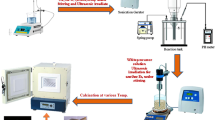Abstract
In this study, the possibility of preparation and application of highly porous silica aerogel-based bioactive materials are presented. The aerogel was combined with hydroxyapatite and β-tricalcium phosphate as bioactive and osteoinductive agents. The porosity of aerogels was in the mesoporous region with a maximum pore diameter of 7.4 and 12.7 nm for the composite materials. The newly developed bioactive materials were characterized by scanning electron microscopy. The in vitro biological effect of these modified surfaces was also tested on SAOS-2 osteogenic sarcoma cells by confocal laser scanning microscopy.
Similar content being viewed by others
References
Lázár I, Manó S, Jónás Z, et al. Mesoporous silica-calcium phosphate composites for experimental bone substitution. Biomechanica Hungarica, 2010, III. 1: 151–158
Dorozhkin S V. Calcium orthophosphates in dentistry. Journal of Materials Science: Materials in Medicine, 2013, 24(6): 1335–1363
Dorozhkin S V. Calcium orthophosphate cements for biomedical application. Journal of Materials Science, 2008, 43(9): 3028–3057
Dorozhkin S V. Biphasic, triphasic and multiphasic calcium orthophosphates. Acta Biomaterialia, 2012, 8(3): 963–977
Monchau F, Hivart P, Genesite B, et al. Calcite as a bone substitute. Comparsion with hydroxyapatite and tricalcium phosphate with regard to the osteoblastic activity. Materials Science and Engineering C, 2013, 33(1): 490–498
Hench L L. Bioceramics. Journal of the American Ceramic Society, 1998, 81(7): 1705–1728
Gittings J P, Bowen C R, Dent A C, et al. Electrical characterization of hydroxyapatite-based bioceramics. Acta Biomaterialia, 2009, 5(2): 743–754
Rezwan K, Chen Q Z, Blaker J J, et al. Biodegradable and bioactive porous polymer/inorganic composite scaffolds for bone tissue engineering. Biomaterials, 2006, 27(18): 3413–3431
Hench L L. Bioceramics: from concept to clinic. Journal of the American Ceramic Society, 1991, 74(7): 1487–1510
Silver I A, Deas J, Erecińska M. Interactions of bioactive glasses with osteoblasts in vitro: effects of 45S5 Bioglass®, and 58S and 77S bioactive glasses on metabolism, intracellular ion concentrations and cell viability. Biomaterials, 2001, 22(2): 175–185
Ohtsuki C, Kamitakahara M, Miyazaki T. Bioactive ceramicbased materials with designed reactivity for bone tissue regeneration. Journal of the Royal Society, Interface, 2009, 6 (Suppl 3): S349–S360
Liu X, Morra M, Carpi A, et al. Bioactive calcium silicate ceramics and coatings. Biomedicine & Pharmacotherapy, 2008, 62 (8): 526–529
Lee E J, Shin D S, Kim H E, et al. Membrane of hybrid chitosan-silica xerogel for guided bone regeneration. Biomaterials, 2009, 30(5): 743–750
Balamurugan A, Rebelo A H S, Lemos A F, et al. Suitability evaluation of sol-gel derived Si-substituted hydroxyapatite for dental and maxillofacial applications through in vitro osteoblasts response. Dental Materials, 2008, 24(10): 1374–1380
Karageorgiou V, Kaplan D. Porosity of 3D biomaterial scaffolds and osteogenesis. Biomaterials, 2005, 26(27): 5474–5491
Sing K S V, Everett D H, Haul R A W, et al. Reporting physisorption data for gas/solid systems with special reference to the determination of surface area and porosity. Pure and Applied Chemistry, 1985, 57(4): 603–619
Tuan R S. Role of adult stem/progenitor cells in osseointegration and implant loosening. International Journal of Oral & Maxillofacial Implants, 2011, 26(Suppl): 50–62, discussion 63–69
Author information
Authors and Affiliations
Corresponding author
Rights and permissions
About this article
Cite this article
Kuttor, A., Szalóki, M., Rente, T. et al. Preparation and application of highly porous aerogel-based bioactive materials in dentistry. Front. Mater. Sci. 8, 46–52 (2014). https://doi.org/10.1007/s11706-014-0231-2
Received:
Accepted:
Published:
Issue Date:
DOI: https://doi.org/10.1007/s11706-014-0231-2




